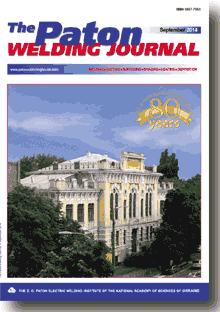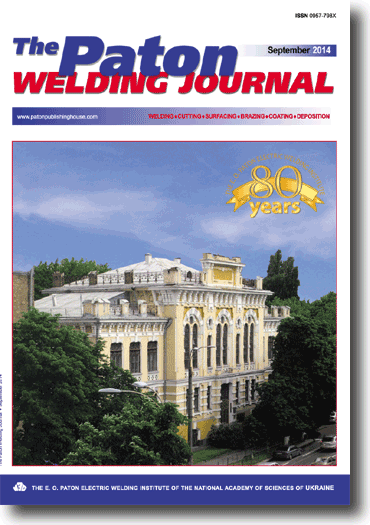| 2014 №09 (07) |
DOI of Article 10.15407/tpwj2014.09.01 |
2014 №09 (02) |

The Paton Welding Journal, 2014, #9, 6-16 pages
DEFORMATION-FREE WELDING OF STRINGER PANELS OF TITANIUM ALLOY VT20
B.E. PATON1, L.M. LOBANOV1, V.L. LYSAK1, V.V. KNYSH1, V.I. PAVLOVSKY1, V.P. PRILUTSKY1, A.N. TIMOSHENKO1, P.V. GONCHAROV1 and GUAN QIAO2
1E.O. Paton Electric Welding Institute, NASU. 11 Bozhenko Str., 03680, Kiev, Ukraine. E-mail: office@paton.kiev.ua
2BAMTRI. Beijing, China. E-mail: guang@cae.cn
Abstract
Presented are the results of complex of carried out investigations on development of technology for welding by penetration welds of stringer panels of titanium alloy VT20 providing minimum residual stresses and deformations and also high values of their life at cyclic loads. On the full-scale specimens, simulating stringer panels, the penetration welds of T-joints were produced using three methods: electron beam, automatic argon-arc nonconsumable-electrode welding over the layer of activating flux, and automatic argon-arc nonconsumable-electrode welding with immersed arc. To prevent the residual welding stresses and deformations, preliminary elastic deformation of elements being welded was applied. The fatigue tests of all the types of specimens at longitudinal cyclic tension were carried out. The effect of heat treatment, impact mechanical treatment and repair-welding technologies on their fatigue life was also determined. Basing on the results of investigations of full-scale specimens the batches of stringer panels of 1200 mm length were manufactured and tested. The penetration welds, made by argon arc non-consumable electrode welding over the layer of activating flux using preliminary elastic deformation and high-frequency mechanical peening of welds, provide the higher values of fatigue life of welded stringer panels of high-strength titanium alloy VT20 as compared to electron beam welding and argon arc non-consumable electrode welding with immersed arc. The developed technology can be accepted for industrial production of welded stringer panels of high-strength titanium alloys. 14 Ref., 1 Table, 13 Figures.
Keywords: thin-sheet welded structures, stringer stiffened panels, T-joints, penetration weld, residual stresses and deformations, preliminary elastic deformation, fatigue strength, high-frequency mechanical peening
Received: 03.12.13
Published: 28.09.14
References
1. Matvienko, S.V., Astafiev, A.R., Karasyov, I.G. (2003) Welding and related technologies in aircraft construction. Tendencies of development. Svarka v Sibiri, 2, 36-40.
2. Robert, W., Messler, J.R. (2007) The greatest story never told: EB welding on the F-14. Welding J., May, 41-47.
3. Bratukhin, A.G., Dmitriev, O.N., Kovalkov, Yu.A. (1997) Stamping, welding, brazing and heat treatment of titanium and its alloys in aircraft construction. Moscow: Mashinostroenie.
4. Paton, B.E. (1992) Advanced trends in improvement of welded structures. In: Welding and Surf. Rev., Vol. 2., 1-8. Amsterdam: Harwood Acad. Publ.
5. Paton, B.E., Utkin, V.F., Lobanov, L.M. et al. (1989) Fabrication of welded large-sized panels from high-strength aluminium alloys. Avtomatich. Svarka, 10, 37-45.
6. Lobanov, L.M., Pavlovsky, V.I., Lysak, V.V. (1987) Elastische Vorspannung beim Schweissen von Duennblechen aus Aluminiumlegierungen. Schweisstechnik, 10, 443, 447-449.
7. Lobanov, L.M., Pavlovsky, V.I., Pivtorak, V.A. (1992) Optical methods of studying and means of controlling welding strains and stresses. In: Welding and Surf. Rev. Amsterdam: Harwood Acad. Publ.
8. Lobanov, L.M., Kirian, V.I., Knysh, V.V. et al. (2006) Improvement of fatigue resistance of welded joints in metal structures by high-frequency mechanical peening (Review). The Paton Welding J., 9, 2-8.
9. Stanhope, F., Hasellhurs, R.H. (1972) Welding airframe structures in titanium alloys using tensile loading as a means of overcoming distortion. In: Proc. of Int. Conf. on Welding and Fabrication of Non-Ferrous Metals (Eastbourne, 1972), Vol. 1, 72-82.
10. Muraviov, V.I. (1986) Specifics of fabrication and quality evaluation of large-sized thin welded structures of VT20 alloy. Avtomatich. Svarka, 8, 15-18.
11. Zamkov, V.N., Prilutsky, V.P., Petrichenko, I.I. et al. (2001) Effect of the method of fusion welding on properties of welded joints in alloy Ti-6Al-4V. The Paton Welding J., 4, 2-6.
12. Savitsky, V.A., Shevelev, A.D., Zamkov, V.N. et al. (1989) Electron beam welding of stiffened panel elements in VT20 titanium alloy. Avtomatich. Svarka, 4, 55-57.
13. Paton, B.E., Zamkov, V.N., Prilutsky, V.P. et al. (2000) Contraction of the welding arc caused by the flux in tungsten-electrode argon-arc welding. The Paton Welding J., 1, 5-11.
14. Lobanov, L.M., Pivtorak, V.A., Savitskaya, E.M. et al. (2011) In-process quality control of welded panels of alloy VT20 using method of electron shearography. Ibid., 11, 22-27.
Suggested Citation
B.E. Paton, L.M. Lobanov, V.L. Lysak, V.V. Knysh, V.I. Pavlovsky, V.P. Prilutsky, A.N. Timoshenko, P.V. Goncharov And Guan Qiao (2014) Deformation-free welding of stringer panels of titanium alloy VT20. The Paton Welding J., 09, 6-16.The cost of subscription/purchase order journals or individual articles
| Journal/Currency | Annual Set | 1 issue printed |
1 issue |
one article |
| TPWJ/USD | 384 $ | 32 $ | 26 $ | 13 $ |
| TPWJ/EUR | 348 € | 29 € | 24 € | 12 € |
| TPWJ/UAH | 7200 UAH | 600 UAH | 600 UAH | 280 UAH |
| AS/UAH | 1800 UAH | 300 UAH | 300 UAH | 150 UAH |
| AS/USD | 192 $ | 32 $ | 26 $ | 13 $ |
| AS/EUR | 180 € | 30 € | 25 € | 12 € |
| SEM/UAH | 1200 UAH | 300 UAH | 300 UAH | 150 UAH |
| SEM/USD | 128 $ | 32 $ | 26 $ | 13 $ |
| SEM/EUR | 120 € | 30 € | 25 € | 12 € |
| TDNK/UAH | 1200 UAH | 300 UAH | 300 UAH | 150 UAH |
| TDNK/USD | 128 $ | 32 $ | 26 $ | 13 $ |
| TDNK/EUR | 120 € | 30 € | 25 € | 15 € |
AS = «Automatic Welding» - 6 issues per year;
TPWJ = «PATON WELDING JOURNAL» - 12 issues per year;
SEM = «Electrometallurgy Today» - 4 issues per year;
TDNK = «Technical Diagnostics and Non-Destructive Testing» - 4 issues per year.


